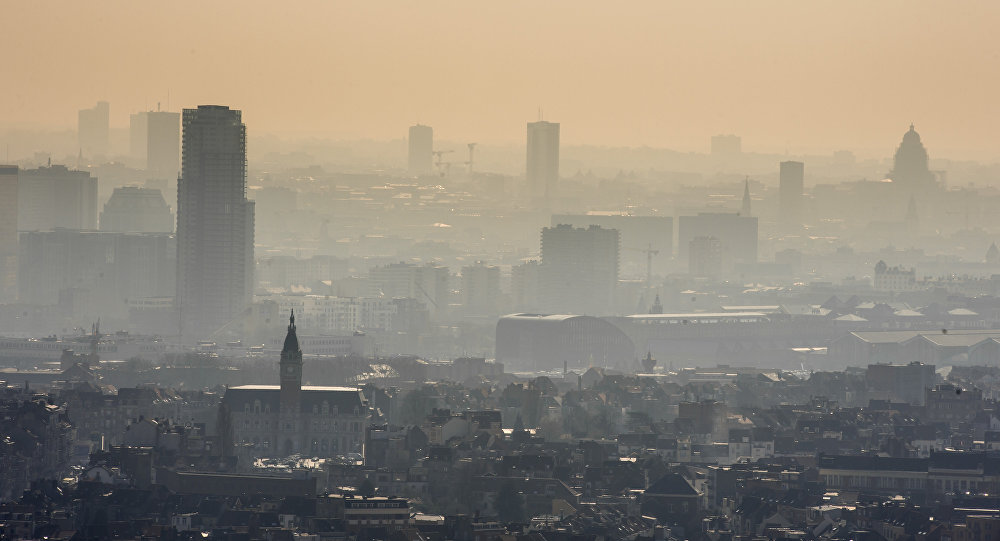Pollution in Brussels: Hold your breath [CaféBabel]
20 March 2017 /

A Brussels’ court allowed the regional government to ignore the pollution levels at Arts-Loi until the end of the year, when an ongoing legal process will end. Pedestrians at Arts-Loi breathed this winter an air whose pollution duplicates the EU limits.

The Brussels court of first instance decided on February 10th to allow the regional government to continue keeping out of the official reports air pollution data from hotspots like Avenue de la Couronne, Belliardand Arts-Loi. A final decision will be taken by the end of year. The Arts-Loi station, which was disconnected in 2008, has registered an average of 84 µg/m3 of NO2 on the air since it was switched back on last December, only with informative value. This figure doubles the level tolerated by the European law -40 µg/m3.
Client Earth, the suing environmental law firm, says the Brussels government uses legal technicality to avoid telling residents the truth about air pollution. Indeed, the Arts-Loi station is located closer than 25 metres from a crossroad, which makes it legally ineligible to be counted on the annual official records. According to Ugo Taddei, Client Earth’s lawyer, the government of the capital region confirmed they won’t use data from Arts-Loi in their annual reports during the court hearings. “They [the regional authorities] know that if they measure the pollution in Arts-Loi there will be significant breaches of the limit value and that will trigger legal consequences in terms of need for additional action”, he says.
If we look at the concentration of NO2, one of the main air pollutants, in the last three months in Brussels, Arts-Loi is the darkest spot in the city (84.3 µg/m3 in average since re-connected), followed by Avenue de la Couronne (82.3) and Voorhaven (74.58), next to the industrial canal. Looking at this graphic, Arts-Loi also stands out for its minimum concentration: 40 µg/m3, equalling the EU annual average top limit. On occasion of Christmas day, pedestrians crossing Arts-Loi got ‘clean’ air as present.
Don’t panic: Brussels is not Beijing
In general terms, the quality of the air in Brussels improves every year, explains Professor Walter Hecq, co-director of the Centre for Economic and Social Studies on the Environment at the Free University of Brussels. Concentration of pollutants like Sulphur dioxide (SO2) has decreased steeply, while fine particles in the air and Nitrogen dioxide (NO2) have shrunk to less extent. Also, prof. Hecq says Brussels‘ pollution levels are not to be comparable to those measured in many countries in Eastern Europe, Asia and Africa. Still, the World Health Organisation (WHO) estimates that Belgians lost 65,000 years of life between 2008 and 2015 due to air pollution; it can be source of cardiovascular and pulmonary diseases and lung cancer.
Taking again NO2 as an example, we can see how most of measuring stations in Brussels go lower than the 40 µg/m3 limit. One still can wonder what would happen if the stations at Arts-Loi and Belliard, disconnected in 2008 and 2014 respectively (Arts-Loi re-connected last December), were considered for official reports.
Yet, peaks of pollution remain a problem. Prof. Hecq explains: “the tendencies can reverse due to punctual meteorological conditions”, for example, when the wind is weaker. Pauline Constant, volunteer of Bruxsel’air, a citizen platform, measured for a week the air she breathes. She registered how she inhaled air with more than 100 µg/m3 of NO2, when biking to work on Wednesday, October 26th. She asks for concrete actions on days of big pollution: “I think about forcing drivers to leave their car in the garage every other day, just like they do in Paris. Instead we’re told we should avoid doing exercise or running. This is not the way I want my child to live”.
Joeri Thijs, spokesperson of Greenpeace Belgium, shares her view: “traffic is not the only reason, but it is the main one”. He advocates for a ban on diesel cars in the city by 2025. In this line, Antwerp introduced last 1st of February a “Low Emissions Zone”: diesel cars produced before 2000 can’t circulate in town; in 2020, the ban will extend to those sold before September 2009. Brussels plans to implement a similar initiative next year.
Although Prof. Hecq confirms cars are the main source of air pollution in the city, he is not sure about the effectiveness of limiting traffic. He argues that only up to 20% of the pollution comes from inside the urban area, while most of the pollution is ‘imported’ from neighboring countries, coming from industry and agriculture. Therefore, “the margin for action is reduced”, he says. Cafébabel asked several times the government of region whether they were planning to take any further actions on tackling air pollution but got no answer so far.
Ivo Alho for CaféBabel
(This article is also available on our partner website)
